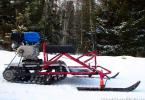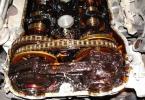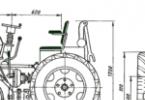And he did not know that tires are not only physics, but also chemistry, with all the ensuing consequences (this, by the way, also applies to the fact of tire aging). The chemical constituent of this product was discussed at the Continental technical seminar.
TASK
The most northern location for the seminar was chosen - a training ground near the Finnish town of Levi. And the main topic of the seminar was the principle of creating an optimal winter tire from the point of view of chemistry. It is the optimal (as you know, ideal tires do not exist), focused on a particular region of use. And above all, taking into account the temperature regimes in that very region. And to begin with, everyone was invited to hit with a hammer on two samples of rubber that had just been removed from the refrigerating chamber. The first sample passed the test without a hint of permanent deformation, and the second, like glass, shattered to smithereens. The thing is that in the first sample, a rubber compound was used, "designed" to a temperature of –60 ° C, and the temperature threshold of the mixture of the second sample did not exceed –20 ° C. By the way, this is a good example of why, when the corresponding season and at a stable temperature below + 7 ° C, it is already worth changing summer tires to winter ones.
These are the components of success: the components involved in creating a tire
It is the rubber compound that is the most important variable, which determines approximately 50% of the changes in tire quality. In total, Continental's developers use 15 chemical components, created using about 1,500 different materials, the various combinations of which determine the characteristics of the tires. And the general technical task for the creators of the rubber compound is formulated quite simply - to ensure the maximum possible adhesion of the tire to the road under specific weather and temperature conditions.
SOLUTION
And then, proceeding from the same technical specifications, the assembly of such a chemical puzzle begins. Does the compound provide elasticity and, consequently, good adhesion properties? Wouldn't the wear resistance of the tire be affected? Trying to provide increased mileage? But to what extent will a tire, the tread of which is prone to "tanning", lose its grip? Carbon black has been used as so-called “fillers” in the tire industry for a long time, and 20 years ago engineers began to use silicon dioxide (silica) - they seriously affect both the grip characteristics of a tire on wet surfaces and its durability. And the optimal balance of these fillers in the chemical composition of the rubber compound of the tread can provide the desired characteristics. The polymers in the rubber compound provide the rubber with the necessary elasticity, and the oils (Continental products also use rapeseed oil) make the rubber softer. As with other ingredients, the amount of oil in a rubber compound can seriously change the characteristics of a product. And already at the stage of vulcanization, the ratio of substances such as zinc oxide and sulfur has a significant effect on the characteristics.

Continental IceContact 2 studs withstand 500 N breakout force
In the course of the seminar, its participants were asked to create an optimal compound for certain conditions from the "components", collecting the same chemical puzzle. As for a practical illustration of these chemical calculations, the following figures can be cited: if the braking distance of winter tires on snow at a speed of 50 km / h is 31 meters, then the braking distance of tires with the same compound, but with a summer tread pattern will already be 42 meters. And just summer tires will go 62 meters. Feel the difference, as they say.
PRODUCT
New products from Continental were also presented at the technical seminar. For example, the studded model IceContact 2. As for the main topic of the seminar, the recipe for the tread compound in this tire was focused on lower temperatures. As in its predecessor, the ContiIce Contact tire, it has an asymmetric tread pattern, but the main feature lies in the spikes. First, there are significantly more of them - 190 instead of 130! But what about the legislation regulating the installation of no more than 50 studs per running meter, you ask. In this case, the Continental developers did the same as their colleagues from Nokian Tires, who proved by special tests that an increase in the number of studs in their product does not have a greater destructive effect on the road surface than tires with a permitted number of studs. The stud of the IceContact 2 tire itself has become smaller and lighter by almost 25%, and a new technology has been used to attach it to the tire tread. The spike is installed in the tire together with a small amount of a special compound, which, during vulcanization, reliably fixes the spike.

This is how Continental winter tire studs evolved
According to the developers, such an innovation improved the tenon anchorage by 400%. The first impressions of the new tires at the test site are very positive. Firstly, very good braking performance on ice. Secondly, when maneuvering on ice and packed snow, the behavior of the tires is quite understandable, without surprises, they have a clear reaction to steering. As for the comfort, including the sound one, it was not possible to check them on the asphalt. But the developers themselves said that they did not forget about this parameter either.
Lending terms:
- Loan term: 2–36 months
- Credit limit: from 10,000 rubles. up to 300,000 rubles
- Interest rate - determined by the bank based on your data and credit history
How to place an order on credit?
To place an order on credit, just follow a few simple steps:- Decide on the product and place an order on the website or through a call center operator
- After placing the order, the bank manager will contact you, advise on the terms of the loan and agree with you on a meeting to sign the contract
- Meet at a convenient time for you with a bank representative and sign the agreement
- After signing the contract, you need to wait for the bank to pay us your order. Money transfer takes 2 to 3 business days. As soon as the money is received from the bank, we will send you an SMS with an offer to pick up the order
- Come to our center with a passport and a loan agreement to receive an order
Loan conditions
- Russian citizenship with permanent registration
- Age from 18 years
- Purchase amount from 10,000 to 300,000 rubles
- Required documents: passport of the Russian Federation, SNILS
Continental Ice Contact 2 studded tires are the second generation of high-performance tires adapted for Russian winters. The latest developments of German engineers are embodied in an updated rubber compound formulation, increased safety and additional comfort. Redesigned metal studs, improved tip placement and asymmetrical tread pattern improve handling. Tire Continental Conti Ice Contact 2 copes with snow-covered tracks and regular trips on cleared city roads.
The advantages of Continental Ice Contact 2 winter tires include:
- the use of multifaceted cores of Kristall studs;
- Studding technology uses the tips in a complex manner;
- workable shoulder and middle protector segments;
- rapeseed oil, silica and polymers soften the tire.
When used in subzero temperatures, the XL reinforced Continental Ice Contact 2 tires retain their original elasticity and softness. In some sizes, the number of lightweight cleats has doubled. Because of this, grip performance and handling on slippery surfaces have increased. The tip loss of Continental Conti Ice Contact winter studded tires is minimized due to the improved retention of the anchors in the compound.
Additional Factory Studding Features
Around each tip there are two ledges with pockets, with the help of which the ice crumbs and snow slurry are discharged. The emergency braking of the Continental Conti Ice Contact 2 winter tires with studs has become controlled, and the drift handling has increased. Reducing the mass of steel auto spikes has led to a decrease in noise and suppression of acoustic stimuli. Continental brand tires for winter are presented in the catalog of the "Wheels for Free" online store. On the website, it is possible to select a suitable standard size and modification online.
- 2% increase in ice control;
- 20-row carbide stud arrangement;
- braking and acceleration improved by 8%.
The store's in-house consultants will help you choose the right wheels. The client will be informed about the availability of the ordered items and the methods of payment. In order to buy cheap car tires, it is better to wait for promotional offers or off-season sales of residues.
Country of origin: Germany, Russia.
Continental Ice Contact 2 SUV test by Finnish Test World conducted in 2016
In 2016, experts from the Finnish organization Test World tested the Continental Ice Contact 2 SUV studded tire in the size of 235/65 R17 and compared it with twelve budget, medium and premium tires.
For clarity of the results, both similar spike tires and friction tires of the Nordic type took part in the test.






Test results
In the test, the Continental IceContact 2 SUV ranked second overall among studded tires. The only "weak" point of the tire was its behavior on wet asphalt, where it showed a relatively long braking distance (albeit with a slight lag behind the studded counterparts). Otherwise, Continental performed well in all disciplines in a balanced manner.
| Discipline | Place | A comment | |
|---|---|---|---|
| Braking on wet asphalt | 12 | a) with the best studded tire (test leader) - 4.2 meters longer; b) with the best friction tire - 3.3 meters longer. |
|
| Snow braking | 7 | Difference in stopping distance: a) with the best studded tire (test leader) - 3 meters longer; b) with the best friction tire - 0.6 meters longer. |
|
| Acceleration in the snow | 1-2 | One of the best results. Difference in acceleration time to 35 km / h: a) with the best studded tire (test leader) - the same result. b) with a better friction tire - 0.6 sec faster. |
|
| Braking on ice | 4 | Difference in stopping distance: a) with a test leader (studded tire) - 3.1 meters longer; b) with the best friction tire - 0.5 meters shorter. |
|
| Acceleration on ice | 2 | Difference in acceleration time to 35 km / h: a) with the best studded tire - less by 0.5 sec; b) with a better friction tire - 0.2 sec faster. |
|
| Noisiness | 8-12 | Subjective assessment of the noise level - 6 points. | |
Review of the experts who conducted the test:
On ice and snow, it provides good braking and predictable handling during extreme maneuvers. They behave well on wet asphalt. On dry, they provide good controllability, but they slow down poorly. Economical in use. Relatively quiet, despite the large number of spikes.
Tested tires list:
The Continental concern, one of the leading international suppliers of automotive components and tire manufacturer, has launched the production of a new premium winter studded tire IceContact 2 at its Kaluga plant.
The new tire will enter the markets of the Scandinavian countries, the Baltic states and Russia this fall. The company claims that the IceContact 2 has improved performance over the previous generation, which was also up to the mark in terms of performance. Thus, the developers managed to improve handling on dry road surfaces by 9%, and on ice - by 2%. The most significant - by 8% - increased such indicators as the transmission of braking and traction on ice. In addition, the IceContact 2 tire guarantees improved handling on snowy roads.
The tread compound of the new Continental tire contains numerous polymers and a large amount of silica filler. In addition, the rubber compound is characterized by a high proportion of rapeseed oil used as a softener, and the accelerators of the vulcanization process optimize the chemical structure of the compound. As a result, the rubber compound remains flexible at low temperatures, which guarantees better grip on the road.
The IceContact 2 has a new asymmetrical tread pattern. The outer part provides good traction for optimal handling, while the inner part provides excellent traction for proper braking and acceleration. This tire will appear on the market this year. The lineup will include 69 standard sizes for passenger cars and SUVs. In 2016, it is planned to replenish the line with new standard sizes.
In the Scandinavian countries, a new type approval standard for studded tires has been in force for the last one and a half years. It describes a test procedure involving 400 drives of a car equipped with studded tires on granite slabs at a speed of 100 km / h. In this test, tires are classified into three categories based on their load index. In order to measure the degree of wear of the road surface, the slabs are weighed before and after the test. Tires are only approved if they meet certain road wear limits. The goal of this regulation is to minimize unwanted wear on the road surface with studded tires.
In collaboration with the University of Karlsruhe (KIT) and using its own drum test bench, Continental has developed a new method for determining road wear with studded tires. The results of the studies carried out made it possible to conclude that the spikes of a smaller size and weight wear the roadway much weaker. Based on these results, Continental has developed a new ultralight cleat for the IceContact 2.
The weight of the new studs is 25% less than in the previous generation. This way, depending on the size, 50% more studs can be installed in the new tire. This increase ensures that the new tire has better on-ice performance than the previous tire without causing more wear on the road surface. In other words, the new tire is able to provide better grip on icy roads typical of the northern region. An additional advantage of the reduced size and weight of the studs is the reduced noise level from the friction of the tire on the road.
The offset arrangement of the spikes ensures that they are in constant contact with the intact ice, and not with the ice that has already been crushed by other spikes. This results in improved grip. To prevent ice from sticking to the spikes, Continental engineers have developed so-called ice pockets, that is, small closed cavities around the spikes in which crushed ice accumulates before it is removed by centrifugal force. This increases safety, especially when braking.
The Continental concern was the first tire manufacturer to develop a technology for reliable stud fixation in a tire, which reduces the likelihood of stud separation from the tread while driving. A special adhesive is applied to the small base of the spikes, after which the spikes are inserted into the tire by a robotic machine. In the next step in the manufacturing process, the studs are fixed in the tire under certain temperature and pressure conditions. Such a technological process increases the strength of the stud fastening in the tire by 4 times as compared to the traditional one. Each such "glued" stud can withstand loads of up to 500 N (50 kg) without traces of separation from the tread.
Due to difficult economic and market conditions, the Moscow office of Continental predicts that the Russian tire market will decline until next year and will return to pre-crisis levels only by 2020.Despite the difficult economic situation, the Continental tire division maintains a stable market share in Russia, which is facilitated by , including an extensive dealer network of about 50 companies and about 400 trade and service centers.Yaron Widmaier, General Director of Continental Tires RUS LLC, notes: “We believe in the development of the Russian market. A reliable and wide dealer network, high quality products, as well as the advantages of local production will allow us to improve our position in the Russian market in the medium term. "
2,500,000 tires rolled off the assembly line of the Continental tire plant in Kaluga in two years. The range of products is also expanding: the plant already produces more than 150 articles of tires of three popular brands in Russia. : Continental- premium, Gislaved- middle price category, Matador- budgetary.
In 2015, the plant began export supplies and work with auto assembly plants. The first consignments of export tires were sent to the Republic of Belarus and Ukraine in April 2015. This was followed by shipments of tires to Germany and France. IceContact 2 tires are being exported to Scandinavian countries.
After the plant in Korbach, Germany, the Kaluga plant became the second enterprise of the concern, which produces winter studded tires. In Kaluga, unique technologies of studding and vulcanization of a stud are used, fully integrated into the production process. This allowed the Kaluga plant Continental in March 2015 to launch mass production of the latest development of the concern - the IceContact2 winter studded tire.“New conditions always dictate new opportunities. Thanks to the well-coordinated and efficient work of the plant's team, which already numbers 950 people, we are able to quickly and efficiently adapt to changes and expand the range of products that we offer to our customers both in Russia and abroad. The Continental concern pays great attention to the technical preparation of its enterprises and the introduction of the most modern technologies. Thanks to this, we have the opportunity to localize here, on the Kaluga land, the unique technologies of the concern, ”notes Georgy Rotov, General Director of Continental Kaluga LLC.
Continental develops smart mobility technologies for people and goods. In 2014, the concern with its five divisions "Chassis & Safety", "Interior equipment" (Interior), "Transmission" (Powertrain), "Tires" (Reifen) and ContiTech reached a turnover of about 34.5 billion Euro. The group employs over 205,000 people in 53 countries.



